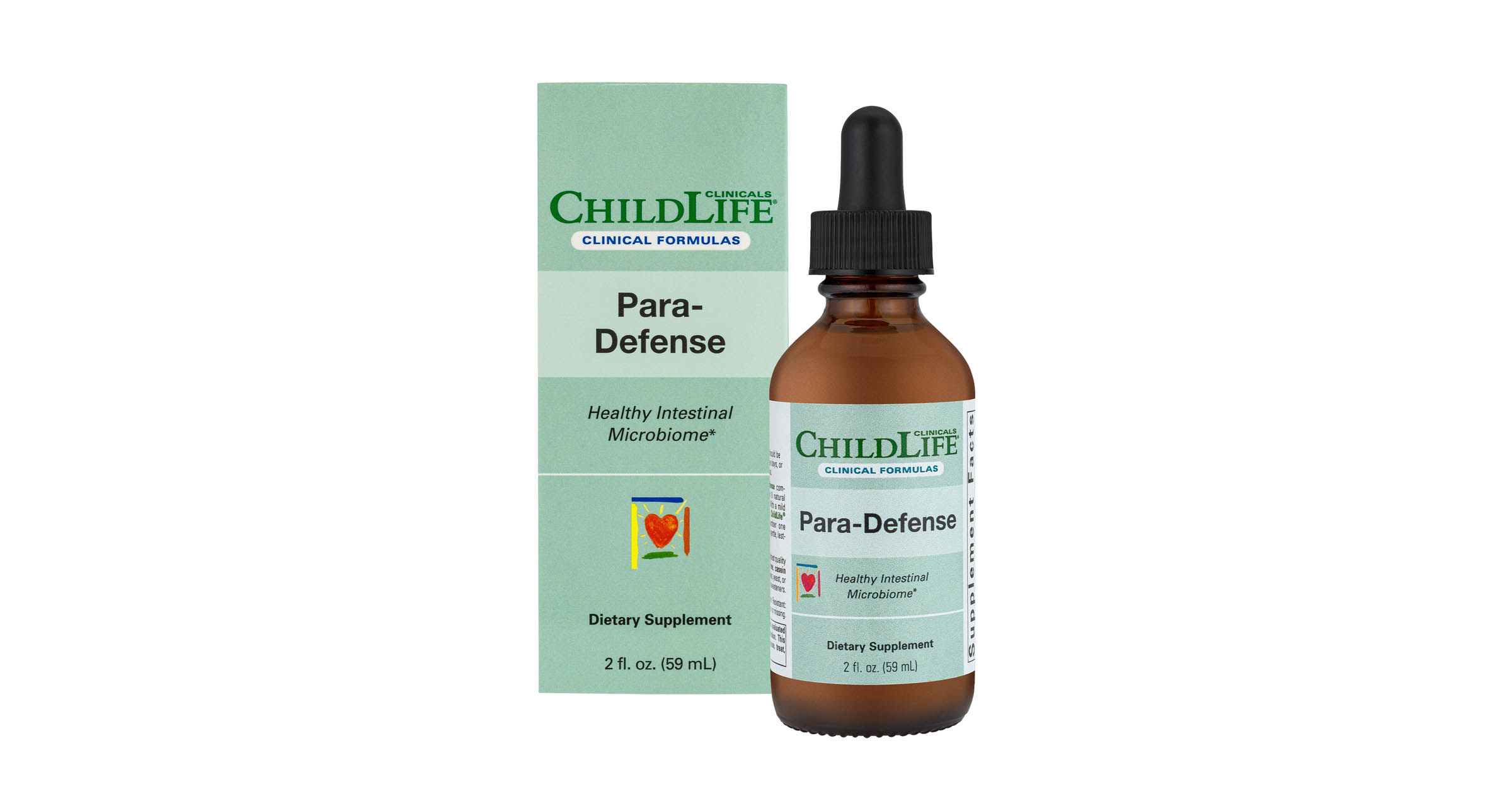Healthy Intestinal Microbiome*
Natural Ingredients with Powerful Benefits
Delivers 83 mg per 0.25 mL Serving:
- Organic Pumpkin Seed
- Organic Olive Leaf
- Organic Red Clover Herb
- Organic Lion’s Mane Mycelia and Fruiting Body
- Wild Crafted Cramp Bark
- Organic Thyme Leaf
- Organic Garlic Bulb
- Organic Clove Bud
- Stevia Leaf Extract
- Fennel Essential Oil
Optimize Early-Life Health with Childlife® Clinicals Para-Defense.
Key Benefits*
- SUPPORTS healthy elimination of undesirable organisms
- DELIVERS all-natural effective ingredients
- PROMOTES optimal health of the digestive tract
- SUITABLE for children all ages, with an easy-to-deliver graduated dropper
* These statements have not been evaluated by the Food and Drug Administration. This product is not intended to diagnose, treat, cure, or prevent any disease.
Purpose: To provide clinicians with technical information to determine if the supplement in question is appropriate for their patient.
Para-Defense
ChildLife® Clinicals Para-Defense contains a proprietary blend of natural ingredients that work within the digestive system to support a healthy gastrointestinal environment. Ingredients included have been shown to assist the body in clearing unwanted organisms.
Childhood Parasites
The World Health Organization estimates that more than 880 million children worldwide suffer from intestinal parasite inhabitation.1 Parasites may enter their host through direct ingestion or contact via multiple channels such as contaminated water or food, walking barefoot in dirt, or poor sanitation measures. Symptoms may be absent altogether, mild as minor abdominal bloating, or more obvious such as cramping, and diarrhea.2 Parasites are capable of causing nutritional deficiencies by interfering with the body’s ability to absorb nutrients. If left untreated, intestinal parasites may compromise host health by depleting nutritional needs.3
Common Parasites
Helminths: Parasitic worms such as ascaris, pin worms, and tape worms, which may be transmitted through contaminated soil.4 Parasitic single-celled organisms: Microscopic in nature, they may transmit themselves via contaminated water and include species such as Entamoeba histolytica, and Giardia intestinalis.5
Fortunately, intestinal parasites can be challenged by incorporating specific herbs and food ingredients with innate properties that disrupt parasite survival.
Ingredients with Antimicrobial or Anthelmintic Properties
- Garlic Allium sativum, has demonstrated ability to control parasitic infection as effectively as some conventional dewormers.6 Intestinal parasites exhibit sensitivity to the active compounds found in garlic.
- Clove Syzygium aromaticum, contains compounds which inhibit parasite adherence to host.7
- Olive Olea europaea, contains compounds that have demonstrated the ability to inhibit parasite replication.8
- Pumpkin seed Cucurbita pepo, studies have shown anthelmintic action in vivo.9 Not only has efficacy been studied, but safety has also been validated for use of pumpkin seeds as a natural anthelmintic.
Ingredients with Antispasmodic properties
To ease the discomfort of having intestinal parasites, antispasmodics are often recommended.
- Thyme Thymus vulgaris, a natural antispasmodic may soothe discomfort associated with gastrointestinal balance disturbances by working to calm contracting muscles of the intestines.10
- Cramp Bark Viburnum opulus, shows strong evidence for smooth muscle relaxation.11
ChildLife® Clinicals Para-Defense includes herbal ingredients that support natural parasite cleansing and ingredients which help relax gastrointestinal muscles for maintaining digestive tract health.
References:
- Intestinal worms. (2016, August 30). Retrieved from https://www.who.int/intestinal_worms/more/en/.
- Haque R. (2007). Human intestinal parasites. Journal of health, population, and nutrition, 25(4), 387–391.
- Hesham MS et al. Med J Malaysia. 2004 Jun;59(2):284-93. Intestinal parasitic infections and micronutrient deficiency: a review.
- Soil-Transmitted Helminths. (2013, January 10). Retrieved from https://www.cdc.gov/parasites/sth/index.html.
- Parasites – About Parasites. (2016, April 22). Retrieved from https://www.cdc.gov/parasites/about.html.
- B.Masamha, et al. (2010) Efficacy of Allium sativum (garlic) in controlling nematode parasites in sheep. Inter J Appl Res Vet Med, 8, 161-169.
- M. Machado, et al. (2011). Anti-Giardia activity of Syzygium aromaticum essential oil and eugenol.Experimental Parasitology, 127(4), 732-739.
- Hashmi, M. A., et al. (2015). Traditional Uses, Phytochemistry, and Pharmacology of Olea europaea (Olive). ECAM. 541591.
- Grzybek M., et. al. (2016). Evaluation of anthelmintic activity and composition of pumpkin (Cucurbita pepo L.) seed extracts—in vitro and in vivo studies. Int. J. Mol. Sci. 17(9), 1456.
- Martínez-Pérez, E. F. et al. (2018). Natural Antispasmodics: Source, Stereochemical Configuration, and Biological Activity. BioMed research international, 3819714.
- Edwards, S. E. et al. (2015). Cramp Bark. Phytopharmacy. doi:10.1002/9781118543436.ch31

